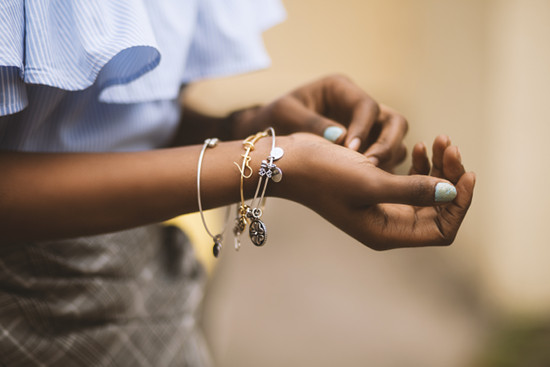
Before purchasing jewelry, it is important that you have the basic knowledge about them. Knowing the type of jewelry you want, what to look for in that type of jewelry and its current market price, can help you find the best one for your budget. Your jewelry knowledge base should cover precious metals and stones, knowing the difference between silver, gold and platinum, know the qualities of 10K, 14K, 18K up to 24K gold and the qualities of diamonds. You may also find useful the knowledge about alternative metals – tungsten, titanium or stainless steel or gemstones, specifically birthstones and other information. The jewelry industry hasn’t lost its luster since the dawn of trade and it will continue to thrive in the future. Being in the know about jewelry can help you find the use of jewelry for different purposes.
Precious Metals
Yellow Gold
This is the most common gold color found in jewelry stores. Pure gold is too soft to hold its shape in fine jewelry, so it is alloyed with other precious metals for added strength. Gold changes color when other metals are added. Gold has a white color when added by white metals like nickel or palladium. Copper can give gold a rose color. Silver added to gold can give it a greenish yellow color. Karat (K) is a measure of gold purity. 24K is the purest form, which is at least 99.9% gold. 18K gold has 75% purity. 14K gold has 58% purity. 10K gold has 41% purity.
White Gold
Some people prefer the whitish to silver color to the yellow color of normal gold. The white color is actually due to the rhodium metal plating added to this type of gold. The lighter the color is, the more strength and durability white gold has.
Platinum
Platinum is similar to white gold in appearance, but is grayish and darker white than white gold. Platinum is naturally white in color and stays this way since the day you bought it, so there is no need for replating. This makes platinum a great precious metal for family heirloom because of its exceptional durability. It is also non-reactive and hypoallergenic qualities, which makes it a good precious metal choice for those with sensitive skin.
Sterling Silver
Pure silver is very soft and malleable, that is why jewelers use sterling silver, which 92.5% pure silver, mixed with other metals such as copper to form an alloy. Silver complements most skin tones, making it a popular jewelry choice among men and women. For this reason, Innovato has a wide range of silver jewelry to choose from, ranging from rings, bracelets, watches, etc. Silver can tarnish, so gentle cleaning with a cloth and metal polish is enough to keep its shine.
Diamond

Diamond is a mineral that is the crystalline form or an allotrope of carbon. Of the 3,000 known minerals, the diamond is one of the most known and most useful. Diamond is known for its hardness and high light dispersion, making it valued for use in jewelry and many industrial applications. The four C’s (Color, Clarity, Cut and Carat weight) is the measure of diamond quality. The knowledge of the four C’s may actually need formal training, but you can at least have an idea of these criteria.
Color
The Gemological Institute of America (GIA) standard for grading diamonds is now the accepted international standard. A diamond that has “fine color” has little or no visible coloration. The less color a diamond has, the greater its value. There are also diamonds outside of the normal GIA color range and they are tagged as fancy-colored.
Clarity
Diamonds have internal features called inclusions, and surface irregularities called blemishes. Together, these are called clarity characteristics. A diamond is said to have high clarity is there is the relative absence of clarity characteristics.
Cut
You may come across terms, “Single Cut,” “Old Mine Cut” or “European Cut” when looking for diamonds. As a value factor, the cut of a diamond refers to its proportions, symmetry and finish.
Proportion – refers to the angles and relative measurements of a polished diamond.
Symmetry – is a grading term used for the exactness of shape and placement of facets.
Finish – is the quality of a diamond’s polish, the condition of its girdle and the precision of the cut
Carat Weight
Diamonds are weighted to one thousandth (0.001) of a carat and then rounded to the nearest hundredth or point. If a diamond weighs over a carat, it is expressed in carats and decimals. For example, a 1.03 carat stone is described as “one point oh three carats,” or “one oh three”.
Jewelry Care
Gold and diamond need extra care to keep their value and also preserve their beauty. At home, you can do basic jewelry care by removing your jewelry when coming home and storing it in a safe place. Most home activities can expose your jewelry to harsh chemicals that could affect jewelry quality or damage it. For diamonds, especially on rings, avoid soaking the ring in chlorinated water in order not to damage the metal prongs. The same care should be given for gold as chlorine can affect gold quality or damage it. When storing diamond, separate it from other precious metals as it can scratch them.
Jewelries are more than just high-value accessories. They can enhance the wearer’s beauty and looks, can accumulate emotional value and can also accumulate economic value. Aside from aesthetic reasons, jewelries can be symbols of prestige, fame and family legacy. Whatever your reason for acquiring jewelry, it is good that you have at least basic knowledge about it to guide you with your choice. You can also ensure that the jewelry will stay for a long time to carry with it the memory and value for the next generation.
